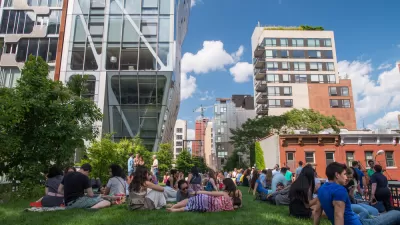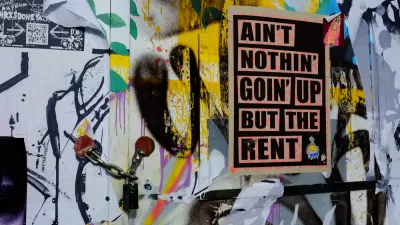The 10th anniversary and updating of Richard Florida's "Rise of the Creative Class" has brought about a re-evaluation of "creative class" urbanism. Will Doig surveys a series of popular essays that question Florida's highly influential arguments.
A flurry of articles in blogs and journals over the last couple of months have argued for the failings of different elements of creative class theory. The most recent of these, appearing in the literary journal The Baffler, "took aim at urbanism's fetish for 'vibrancy,' and called the coolness-will-save-us model a 'Ponzi scheme' that needs to be stopped," notes Doig.
He suggests there is a growing conversation, and concern, "that much of today's
urbanism, even when its goals are lofty, is too muddled with buzzwords,
corporate-speak and privileged points of view." While counter-arguments to Florida often dwell on semantics rather than substance, Doig argues that at the heart of the criticisms lies a spreading anxiety, "that
some of this stuff - the streetcars, the pop-up cafes, the activated
spaces, the 'vibrancy' - is frivolous and insubstantial."
And the fact that many of these dissenting articles appear in "small publications, written by people who aren't as invested in urbanism as a movement," Doig seems to argue, is their greatest credential. Planners, as a lot, are remiss if they aren't invariably suspicious of the type of sure-minded group-think that brought about the disastrous urban renewal schemes of the 1950s and 60s. And Doig seems to play on this suspicion by making an analogy between these articles and the work of "local activists" who by the mid 1960s, "had been writing for years in
community newspapers about the destructiveness of urban renewal
policies, that they were doing more harm than good."
"Meanwhile," Doig continues, "the New
York Times was still running
Op-Eds promoting 'the long-standing national goal of tearing down all
slums and providing every American family with ‘a safe, decent and
sanitary home.''
Because, "The Times, along with some of the brightest minds of that generation,
was wrong about cities," concludes Doig, "Some of the ideas that are being implemented [now]
might also be wrong..."
FULL STORY: Hipsters won’t save us

Alabama: Trump Terminates Settlements for Black Communities Harmed By Raw Sewage
Trump deemed the landmark civil rights agreement “illegal DEI and environmental justice policy.”

Planetizen Federal Action Tracker
A weekly monitor of how Trump’s orders and actions are impacting planners and planning in America.

The 120 Year Old Tiny Home Villages That Sheltered San Francisco’s Earthquake Refugees
More than a century ago, San Francisco mobilized to house thousands of residents displaced by the 1906 earthquake. Could their strategy offer a model for the present?

In Both Crashes and Crime, Public Transportation is Far Safer than Driving
Contrary to popular assumptions, public transportation has far lower crash and crime rates than automobile travel. For safer communities, improve and encourage transit travel.

Report: Zoning Reforms Should Complement Nashville’s Ambitious Transit Plan
Without reform, restrictive zoning codes will limit the impact of the city’s planned transit expansion and could exclude some of the residents who depend on transit the most.

Judge Orders Release of Frozen IRA, IIJA Funding
The decision is a victory for environmental groups who charged that freezing funds for critical infrastructure and disaster response programs caused “real and irreparable harm” to communities.
Urban Design for Planners 1: Software Tools
This six-course series explores essential urban design concepts using open source software and equips planners with the tools they need to participate fully in the urban design process.
Planning for Universal Design
Learn the tools for implementing Universal Design in planning regulations.
Clanton & Associates, Inc.
Jessamine County Fiscal Court
Institute for Housing and Urban Development Studies (IHS)
City of Grandview
Harvard GSD Executive Education
Toledo-Lucas County Plan Commissions
Salt Lake City
NYU Wagner Graduate School of Public Service




























